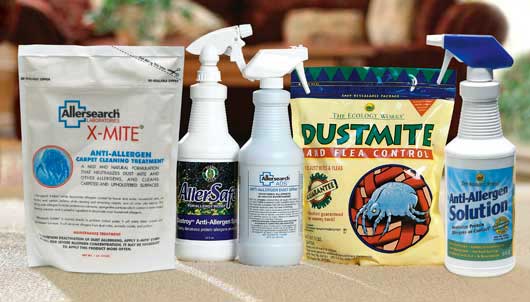Dust Mite Treatments
Dust Mites Treatments and Products for Your Home
- Are Dust Mites Causing My Allergy Symptoms?
- I've Encased My Bedding, Now What?
- Which Dust Mite Treatment Product is Best for Me?
- Helpful Tips for Vacuuming and Dusting
- How Can I Be Sure I Have a Dust Mite Problem?
Are Dust Mites Causing My Allergy Symptoms?
The short answer is...quite possibly. Remember that dust mites are microscopic organisms that love warm, humid, and fibrous environments where there is plenty of food (they primarily eat our shed, dead skin cells, and other organic matter like mold spores). Although they avoid human contact, dust mites rapidly-produce a waste product that is easily inhaled, causing airways to become hyper-responsive in mite-sensitive individuals. Regardless of how well you clean, dust mites are simply a part of the environment and, therefore, extremely prevalent in nearly all homes.
"The most important factor in an environmental control program is avoidance of dust mite allergen. Sensitivity to dust mite antigen is a strong predictor of asthma and asthma severity, and reducing dust mite allergen exposure in the home can reduce the severity of asthma, eczema, and allergic rhinitis... Household areas with the highest levels of dust mite infestation include the following: carpets, pillows, mattresses, drapes, stuffed animals, clothing, and upholstered furniture."Jeffrey A. German, MD and Michael B. Harper, MD. "Environmental Control of Allergic Diseases." American Family Physician. American Academy of Family Physicians, 1 Aug. 2002. Web. 3 Sept. 2014.
In our library page on dust mites we discuss the importance of controlling dust mite allergen in mattresses, pillows, and other bedding because your bed and bedding meet all the criteria that dust mites love best. Even hypoallergenic pillows and mattresses should be encased because they too will become havens for dust mites. After bedding, dust mites next love to colonize carpeting, sofas, and even that favorite overstuffed TV chair in the family room. This article focuses on how to control dust mites in carpet and soft furnishings.
I've Encased My Bedding, Now What?
After investing in dust mite-proof bed encasings, doctors across the board recommend removing carpet and limiting the use of upholstered and fiber-filled furniture. Dr. Michael Berry, now retired from the EPA, states that "Carpeting and fabrics not cleaned and properly maintained have the potential to cause a variety of health problems inside the building environment."
Carpets are usually heavily infested with dust mites, with wall-to-wall carpeting being the most troublesome because it is so difficult to clean everywhere. Regardless, many enjoy the feel and comfort of wall-to-wall carpet and upholstered furniture and don't want the hassle or expense of removal and replacement. So, although removal is the ideal solution and truly the best for allergy sufferers, many folks need another option.
Simple household chores, such as frequent vacuuming and dusting, can help reduce the amount of dust and surface allergen. However, since dust mites burrow deep into carpeting and upholstery, the usual vacuuming cannot reach them.
"Regular vacuum cleaning removes surface mites and allergens, but it does not remove deeply embedded allergens or reduce the number of live mites."Larry G. Arlian, Ph.D. and Thomas A. E. Platts-Mills, MD, Ph.D. "The biology of dust mites and the remediation of mite allergens in allergic disease." Journal of Allergy and Clinical Immunology. March 2001: part 2, Volume 107; Number 3: 406-413.
Thankfully, there are a number of dust mite treatment products available to help, and they provide a great way for dust mite-sensitive people to survive without having to re-decorate or spend hours each week vacuuming! These home treatments are safe and effective and can really help to reduce the allergic symptoms associated with dust mites and, in some cases, even animal dander and mold.
Which Dust Mite Treatment Product is Best for Me?
Outlined below are the treatment products offered by National Allergy. We hope that the following chart will be a handy reference for you as you decide which product would work best for you and your home. The different treatments affect dust mites in different ways. Some will neutralize the protein in their allergen rendering it harmless, while others actually kill the mites themselves. Of course, each product requires a slightly different application and routine for maximum effectiveness.
All of the following dust mite treatment products have been tested in published medical studies or by independent labs with demonstrated effectiveness. Although these products have been shown to be safe, please read the entire product label prior to use.

| Product: | Where to Use: | How to Apply: | How Often: | Coverage: | Effect: | Active Ingredients: | Pricing: |
| Anti-Allergen Solution Spray | Carpets, rugs, upholstered furniture, curtains & pet bedding | Spray on after vacuuming or steam cleaning | Every 2 months | 32-oz. Bottle covers 500-800 sq. ft. | Neutralizes dust mite & other allergens | Plant-based. Odorless & colorless. Non-staining. | 3-oz. $6.99 ---- 32-oz. $20.99 ---- Gallon $61.96 |
| DustMitex Pre-Mixed Spray | Carpets, rugs, fabric & upholstered furniture | Spray on after vacuuming or steam cleaning | Twice a year | 32-oz. Bottle covers 100 sq. ft. | Kills dust mites | Boron compound. Odorless & colorless. | 32-oz. $10.49 |
| DustMite and Flea Control Powder | Carpets, rugs, & upholstered furniture | Mix with water & use as a spray or in a carpet cleaning machine | Twice a year | 2-lb. Bag covers 800 sq. ft. as a spray or 400 sq. ft. in a carpet cleaner | Kills dust mites | Boron compound. Odorless & colorless. | 8-oz. $10.49
----
2-lb. $31.96 |
| Allersearch ADS Spray | Carpets, rugs, & some upholstered furniture | Spray on dry surface to dampen. Allow to dry, then vacuum | Every 2-3 months | 32-oz. Bottle covers 600 sq. ft. | Neutralizes dust mite and other allergens | 3% tannic acid. Virtually odorless | 32-oz. $34.95 ---- Gallon $99.95 |
| Allersearch X-Mite Powder | Carpets, rugs, & some upholstered furniture | Brush into carpet or furniture, let dry and vacuum | Every 2-3 months | 1 lb. Bag treats 150 sq. ft. | Neutralizes dust mite and other allergens. Cleans and freshens carpet. | 3% tannic acid. Virtually odorless. | 1 lb. $21.95 |
| Allersearch ADMS Spray | Carpets, rugs, upholstered furniture, & curtains | Spray on after vacuuming or steam cleaning | Every 30 days | 32-oz. Bottle covers 600 sq. ft. | Neutralizes dust mite and other allergens | Safe, inorganic compounds. Non-staining. | 32-oz. $21.95 ---- Gallon $39.95 |
Helpful Tips for Vacuuming & Dusting
As noted, several of the treatments listed above require vacuuming prior to or following application. Additionally, research has shown that frequent vacuuming can be a help in general. Central vacuum systems are the best option, as there are no exhaust emissions to aggravate allergies because the collection canister is usually located in a garage or basement. The downside is the expense of installation. Uprights or canister vaccums are the next best choice, but should come equipped with (or have the option of using) a HEPA filter to ensure particles you just vacuumed don't get released back into the air.
Central vacuum systems are the best option, as there are no exhaust emissions to aggravate allergies because the collection canister is usually located in a garage or basement. The downside is the expense of installation. Uprights or canister vaccums are the next best choice, but should come equipped with (or have the option of using) a HEPA filter to ensure particles you just vacuumed don't get released back into the air.
Ideally, the HEPA vacuum should also have a sealed filtration system, such as the Miele S7 uprights. These machines provide the best protection for allergy sufferers because there are virtually no leaks, and the exhaust is filtered.
If you don't have one of these vacuums and are not planning a purchase anytime soon, all is not lost. Special vacuum bags may be available for your current model. These bags offer a great way to improve the dust and allergen-trapping ability of your current vacuum. Most, if not all, come with a locking or other self-closure system for hygienic and allergen-free bag removal and disposal.
Dusting is another dreaded household chore that can truly help control dust and allergen accumulation in the home. But be sure to use a dust cloth that picks up dust rather than stirs it up. Our Dust Grabber has long been a favorite due to its magnet-like charge – dust really clings to these cloths, and they can be washed and used over and over again. Likewise, use only a dust mop with great dust-trapping ability to avoid stirring up dust as you mop. If you do have extreme allergies, you should either wear a good face mask while dusting or vacuuming or have someone else do these chores for you.
How Can I Be Sure I Have a Dust Mite Problem?
Unfortunately, dust mites are a reality in almost every home regardless of the cleanliness, age, region, or size of your home. Warmth and humidity play a very big role in dust mite levels. If you live in a very warm and humid environment and do not dehumidify 24/7, your dust mite levels will be higher than if you live in a very cool and dry climate.
If you want to know more precisely what you are facing, tests are available that can help measure the severity of the dust mite problem. Generally, these tests are easy to use, allowing you to detect clinically significant levels of dust mite allergen in furniture, bedding, or carpets. Once you've begun taking measures to control dust mites in your home, testing is also a great way to monitor progress. If you are unsure if you or a family member has allergies, visit your local allergist for an allergy test.


